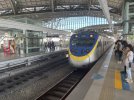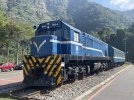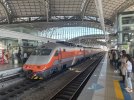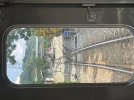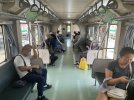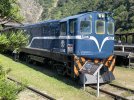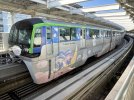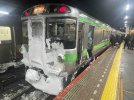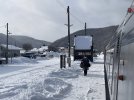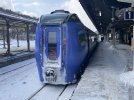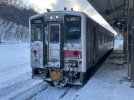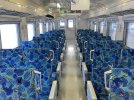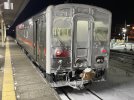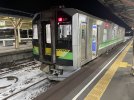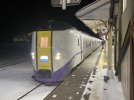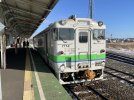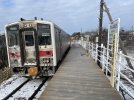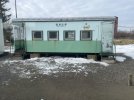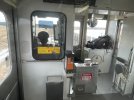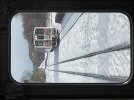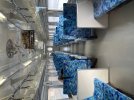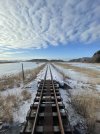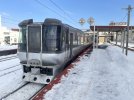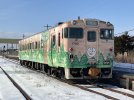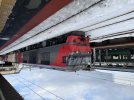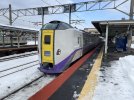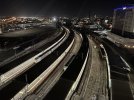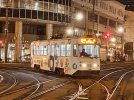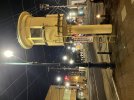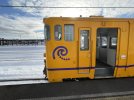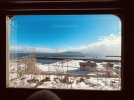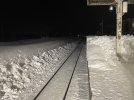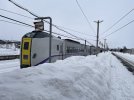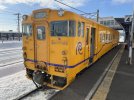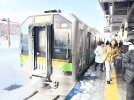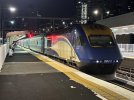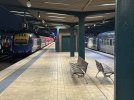I have a few interesting rail trips coming up over the next few months, and, having read this part of the forum over the past few years and taken some inspiration from trips of some regular contributors here, I thought I’d have a go at writing a few trip reports myself.
Firstly, a bit of a back story. I’m a Cornishman, and after twenty-something years of a very fortunate career that’s taken me to Asia (presently Hong Kong) for the last ten years, I have finally found myself with a few months off - a few months that I fully intend to make the most of! My partner is somewhat sympathetic to my enjoyment in travelling by train and ferry - she’ll do it for an experience, but draws the line on doing it for the sake of it. She has a career of her own, and doesn’t have the luxury of a few months off, so my travels over the next few months will be mostly without her, but occasionally (like the first trip) with her.
From a rail perspective, my interest in trains started with standing on the breakwater wall on Penzance station on Summer Saturday afternoons in the late 80s/early 90s with my dad - I have a distinct memory of waiting for the first glimpse of the outline of carriages passing Long Rock depot several minutes away, bringing holidaymakers from seemingly far distant glamorous destinations I could only dream of - Leeds, Liverpool Lime Street, Newcastle and the regular HSTs from Paignton. We subsequently moved to Yeovil during the dying days of the Class 50s on Waterloo to Exeter.
Putting memory lane aside for now, I very much enjoy building rail travel for the sake of it into my trips around Asia. Whilst in the UK I take a keen interest in the traction, while abroad it’s more about the experience, the ambience, and the view out of the window. A day is never wasted while sitting on a train getting a feel for the countryside and people in the carriage with you, broken up every few hours with a ramble around a town not generally on the tourist trail. I do too much plane travel for business, but as soon as you go somewhere by train, I feel it’s “real travel”.
Anyway, for the first adventure, we find ourselves in Hanoi, Vietnam on a Wednesday evening a couple of weeks ago in late October. The real heat of the summer has just started to subside, but it’s still hot and sweaty enough that my t-shirt is slightly moist from the walk round the city earlier in the day (detail you perhaps didn’t need!). We’re on the famed “train street” for a couple of drinks before heading to the station to board our train. The train street thing a bit of a lie to be honest - there’s actually several “Train Street”s in Hanoi, each trying to appear more prominent on Google Maps and Maps.me to draw the tourists. I’m sure most of you have seen the videos of trains making their way down the middle of a street of bars, making their way between two rows of backpackers drinking, squeezed against the wall.
The rules have changed since I was last here pre-Covid. The local government seem to have woken up to the fact that large unstoppable passenger and frieght trains and drunk westerners on nights out aren’t necessarily ideal bedfellows. They’ve tried to enforce a rule that only householders and their invitees are permitted to enter the train street. I was not aware of this. I tried to walk onto the train street, and a burly security guard fiercely blew his whistle at me, and instructed me that I not permitted to enter. In the split second that I turned round in a state of slight confusion, a Vietnamese lady wearing a t-shirt emblazoned with a large teddy bear told me she could get me in. My partner and I followed her.
I had the moment you quite often get travelling in an unfamiliar country - unsure whether someone is genuinely trying to assist you, or whether you’re about to find yourself in an uncomfortable situation as the certainty you’re being scammed creeps in. Fortunately on this occasion, it was the former - the lady couldn’t have been nicer and she explained the “security rules” that we were now guests of her household, set us up with some tables by the train line, and presented us with a beer menu complete with reasonable prices. She took the names of the friends we were trying to meet, and told us to take a photo of her “teddy” shirt and told us to direct them to find her so that they could also be her “guests”.
Because the lady’s hospitality was fabulous - we stayed her for three hours or so, and drank several more drinks than intended, including some of her father’s home made apple cider, which in truth was probably only drinkable by virtue of the number of beers that had preceded it. Whilst on the street two trains had passed - a surprisingly long container train which passed us at considerable speed, and a passenger train. The train street would strike the fear of god into anyone in a safety critical rule on the UK railways - it wasn’t so much a case of being able to reach out to touch the train, more a case of needed to make sure i contorted myself in such a way so as not to get clouted by a passing staircase sticking out at each doorway. We joined the hordes in placing coins and bottle tops on the line in advance of the train’s arrival to collect flattened afterwards. I had a mental image of the coins being flicked towards me at great speed by passing flanges, although this didn’t seem to be a problem. As much as I enjoyed the experience, it’s hard not to feel that the Vietnamese authorities attempts to close it down aren’t well-placed.
We left just after 9pm to do the 15 minute walk (including several games of chicken with Hanoi traffic) to catch the 10pm train from Hanoi’s rather utilitarian station to Lao Cai in northern Vietnam. This was my partner’s first experience of an overnight sleeper train, and I very much wanted her to enjoy it so I could convince her to do similar things on trips in the future.
There are two trains nightly from Hanoi to northern Vietnam. They are long trains - I think I counted 15 carrriages on ours. There are carriages belonging to the national operator, but each train then includes several other carriages owned and run by private operators - a bit like the Stagecoach coaches on the Aberdeen sleeper pre-privatisation. To try to get my partner the best experience possible, I’d tried to book the most luxurious of these, run by a company called “Vic-Sapa Trains”, at a cost of US$90 each. However, this had been fully booked on our outward journey, so the representative of that firm - who was amazingly helpful - had been emailing me and had offered to arrange us a bed in the second best “Sapaly Express” carriage at US$85.
We reached the featureless, utilitarian station. I needed to pick up the “Sapaly Express” ticket, rather weirdly, from a portable stand next to a kiosk outside the station. This was easily achieved. Access to the tracks at Hanoi is through a concourse on the first level that leads onto the footbridge. Hanoi station seems to have a ton of capacity - there were, from memory, 12 platforms, and a similar number of daily departures. It appears this train sits in the platform all day between its 0525 arrival and 2200 departure.
We found and boarded the Sapaly Express carriage and found our two berth cabin. We were shown to our cabin, and asked if we wanted tea or coffee first thing in the morning. I’d tried Vietnamese coffee enough times to know that the answer to this question needed to be ‘tea’.
First impressions were quite positive - the train was old, but similarly appointed to the old GWR cabins on the Night Riveira, although with one single bed on either side and no sink in the room. Fully lockable from the inside, with a couple of duvets for each bed of different thicknesses, adequate air conditioning (necessary in the warm climate), and a fixed table between the beds with a desklamp, and a small snacks tray including water, a sprite, and a beer each, which I happily consumed as the train departed at 10pm.
We waved goodbye to the friends we’d left on the train street as we passed through, and settled in for the night. This is when we realised our biggest problem for the night - despite being quite central in the carriage, there was an exceptionally loud bang emanating from the underneath of the carriage every few seconds. I don’t know enough about railway engineering to know what would cause this, but as we tried to sleep, it was a sound akin to someone thumping the bottom of your bed every few seconds. The bed itself was a little thin (like the Night Riviera beds) but otherwise quite comfortable. As well as the banging from underneath, the air conditioning vent on the roof was clattering on a regular basis. Eventually, after several hours, I did drift off to sleep. As always on sleeper trains, you wake fairly regularly, and the train stopped at a wayside halt every forty minutes or so. On a couple of occasions, I regretted the quantity of beer and apple wine consumed, as I had to get fully dressed and make my way to either end of the carriage to the scruffy toilet, which was just about acceptable.
Eventually, the train stopped at a station sometime after 5.15. We’d expected an arrival time of 5.55am at the end destination. I don’t like brushing my teeth in the vicinity of strangers, so I did a mental calculation that most would likely set an alarm clock for 5.30, and decided to go to the side-by-side common sinks at twenty past five to make my ablutions, which I successfully achieved without having to meet anyone at such an ungodly hour.
I looked at my GPS, compared to the train timetable, and realised the train was running around 40 minutes late. I looked out the window just as the day broke. There was a misty greyness to it all, but as we passed a couple of tiny hamlets I got that wonderful travel feeling of being somewhere new, somewhere interesting, doing something unusual. You just don’t get that on a plane.
I returned to a cabin comprising my very unhappy partner, who had found the cabin far too cold for her liking (it was fine for me, but we have an endless battle over air conditioning), hadn’t slept much, and wasn’t overly happy with the sleeper train experience, making comments about the misuse of ‘luxury’ in Sapaly Express’s marketing material. This was exacerbated when the carriage attendant made us unpack half our luggage to pay an amount equivalent to 20p each for the morning tea that we’d assumed was complimentary.
The experiment of taking my other half on night trains was failing, and I wasn’t likely to be sipping a pint of Doom Bar on the Night Riviera through Reading any time soon.
We spent three days in the mountain resort of Sapa (the first one in a tired haze), which was an interesting place to go - a short bus ride from the train’s northern terminus of Lao Cai. Amazing sights up the mountains. We’d hired motorbikes in Sapa on the final day before getting the train home, and travelled over Vietnam’s highest road. It had poured with rain, and, at over 2,500 metres, my decision to take only t shirts and shorts for a week in Vietnam was a very bad one. The temperature at that altitude was down to about 16C, but the heavy rain, and the breeze while I was on the bike meant I was still shivering when we got off the bus in Lao Cai.
Lao Cai is a couple of kilometres south of the Chinese border and very much feels like a border town. A bit windswept. A lot of rail infrastructure, some parked freight wagons and a few silent locomotives awaiting their next duty. There’s no through passenger operations from China to Vietnam this way (the Hanoi to Nanning trains go a different way, I think). I think it’s correct to say the railways here are different gauges - but happy to be corrected on this point. So there’s only the two night trains to Hanoi each day. Surprisingly, there’s no day train although some internet research suggests there was pre-Covid. If there had been, I’d have taken it just to look out the window.
The return trip in the Vic-Sapa carriage was a much, much more positive experience to the one out. By the time of our 2130 departure, we were already settled into our double bed in our cozy cabin. The cabin had little more than a double bed arranged with our feet in the direction of travel and a small space between the bed and the sliding door, with a small cupboard on either side of the door which doubled up as a bedside cabinet. This really did fit the definition of luxury. As soon as the train departed, we opened the curtains and lay in the enormously comfortable bed staring out the window while playing Risk on the iPad, consuming the complementaries that had been left in the room. Again, a couple of beers, some soft drinks, some water, some rice cakes and a couple of chocolates. All were consumed, mostly in celebration of the fact there was no ‘thumping bang’ from the underside of the train in this carriage.
The communal areas of the train were also beautifully fitted out with faux marble floors and lovely wooden door panels etc. It was newly decorated - the website indicated it was less than six months old. In some cases (i.e. the compartment door), it had been badly designed and scratches were appearing. It’s new enough that this doesn’t hurt the ambience but I’d imagine over time this will look worse.
Most bizarre (but not unpleasant) was the toilet I was using. I think this was actually in the next carriage and I’m not sure this was a Vic-Sapa carriage. The toilet, which was spotlessly clean, had been decked out with a brick tiles to make it look like a brick wall. Very strange, it felt like I could have been in the corner of a building site. However, because it was so clean, it was nice to use. There were both communal sink facilities and a sink in the brick toilet.
After using the bathroom, I returned to the cabin and we turned the lights off. Within minutes, we were asleep, and other than stirring at a couple of intermediate stations, we slept soundly. I awoke at 4.50am, and applying the same logic as I’d used on the way out, made my way to the bathroom to prepare for the day in advance of the 5.25am arrival.
We’d both felt this had been a much more pleasurable experience, and thankfully, I think the experience was good enough that my partner will be convinced to do a sleeper train again. I also assured her that most sleeper trains don’t involve quite such an early arrival in the morning, and the experience is much more pleasurable. The post 8am arrival in Penzance seems like a dream when in Vietnam. In both directions, we were on the later of the two overnight trains - I’ve no idea why Vietnam Railways don’t run these trains a couple of hours later but I assume there’s a reason.
Overall, a really interesting couple of days. I’m not sure we’ll feel the need to go to Sapa again. For anyone considering heading up to Northern Vietnam, I would give the train a go. I’d rather have had a day train in one direction, and the extra $5 for the Vic-Sapa Train was worth every cent.
If I can work out how to upload pictures I’ll add some.
And so ends my first foray into Trip Reporting - I now appreciate the amount of effort all the regulars put into it - it takes quite a bit of time! Perhaps in future I’ll learn to be less ‘wordy’!
Firstly, a bit of a back story. I’m a Cornishman, and after twenty-something years of a very fortunate career that’s taken me to Asia (presently Hong Kong) for the last ten years, I have finally found myself with a few months off - a few months that I fully intend to make the most of! My partner is somewhat sympathetic to my enjoyment in travelling by train and ferry - she’ll do it for an experience, but draws the line on doing it for the sake of it. She has a career of her own, and doesn’t have the luxury of a few months off, so my travels over the next few months will be mostly without her, but occasionally (like the first trip) with her.
From a rail perspective, my interest in trains started with standing on the breakwater wall on Penzance station on Summer Saturday afternoons in the late 80s/early 90s with my dad - I have a distinct memory of waiting for the first glimpse of the outline of carriages passing Long Rock depot several minutes away, bringing holidaymakers from seemingly far distant glamorous destinations I could only dream of - Leeds, Liverpool Lime Street, Newcastle and the regular HSTs from Paignton. We subsequently moved to Yeovil during the dying days of the Class 50s on Waterloo to Exeter.
Putting memory lane aside for now, I very much enjoy building rail travel for the sake of it into my trips around Asia. Whilst in the UK I take a keen interest in the traction, while abroad it’s more about the experience, the ambience, and the view out of the window. A day is never wasted while sitting on a train getting a feel for the countryside and people in the carriage with you, broken up every few hours with a ramble around a town not generally on the tourist trail. I do too much plane travel for business, but as soon as you go somewhere by train, I feel it’s “real travel”.
Anyway, for the first adventure, we find ourselves in Hanoi, Vietnam on a Wednesday evening a couple of weeks ago in late October. The real heat of the summer has just started to subside, but it’s still hot and sweaty enough that my t-shirt is slightly moist from the walk round the city earlier in the day (detail you perhaps didn’t need!). We’re on the famed “train street” for a couple of drinks before heading to the station to board our train. The train street thing a bit of a lie to be honest - there’s actually several “Train Street”s in Hanoi, each trying to appear more prominent on Google Maps and Maps.me to draw the tourists. I’m sure most of you have seen the videos of trains making their way down the middle of a street of bars, making their way between two rows of backpackers drinking, squeezed against the wall.
The rules have changed since I was last here pre-Covid. The local government seem to have woken up to the fact that large unstoppable passenger and frieght trains and drunk westerners on nights out aren’t necessarily ideal bedfellows. They’ve tried to enforce a rule that only householders and their invitees are permitted to enter the train street. I was not aware of this. I tried to walk onto the train street, and a burly security guard fiercely blew his whistle at me, and instructed me that I not permitted to enter. In the split second that I turned round in a state of slight confusion, a Vietnamese lady wearing a t-shirt emblazoned with a large teddy bear told me she could get me in. My partner and I followed her.
I had the moment you quite often get travelling in an unfamiliar country - unsure whether someone is genuinely trying to assist you, or whether you’re about to find yourself in an uncomfortable situation as the certainty you’re being scammed creeps in. Fortunately on this occasion, it was the former - the lady couldn’t have been nicer and she explained the “security rules” that we were now guests of her household, set us up with some tables by the train line, and presented us with a beer menu complete with reasonable prices. She took the names of the friends we were trying to meet, and told us to take a photo of her “teddy” shirt and told us to direct them to find her so that they could also be her “guests”.
Because the lady’s hospitality was fabulous - we stayed her for three hours or so, and drank several more drinks than intended, including some of her father’s home made apple cider, which in truth was probably only drinkable by virtue of the number of beers that had preceded it. Whilst on the street two trains had passed - a surprisingly long container train which passed us at considerable speed, and a passenger train. The train street would strike the fear of god into anyone in a safety critical rule on the UK railways - it wasn’t so much a case of being able to reach out to touch the train, more a case of needed to make sure i contorted myself in such a way so as not to get clouted by a passing staircase sticking out at each doorway. We joined the hordes in placing coins and bottle tops on the line in advance of the train’s arrival to collect flattened afterwards. I had a mental image of the coins being flicked towards me at great speed by passing flanges, although this didn’t seem to be a problem. As much as I enjoyed the experience, it’s hard not to feel that the Vietnamese authorities attempts to close it down aren’t well-placed.
We left just after 9pm to do the 15 minute walk (including several games of chicken with Hanoi traffic) to catch the 10pm train from Hanoi’s rather utilitarian station to Lao Cai in northern Vietnam. This was my partner’s first experience of an overnight sleeper train, and I very much wanted her to enjoy it so I could convince her to do similar things on trips in the future.
There are two trains nightly from Hanoi to northern Vietnam. They are long trains - I think I counted 15 carrriages on ours. There are carriages belonging to the national operator, but each train then includes several other carriages owned and run by private operators - a bit like the Stagecoach coaches on the Aberdeen sleeper pre-privatisation. To try to get my partner the best experience possible, I’d tried to book the most luxurious of these, run by a company called “Vic-Sapa Trains”, at a cost of US$90 each. However, this had been fully booked on our outward journey, so the representative of that firm - who was amazingly helpful - had been emailing me and had offered to arrange us a bed in the second best “Sapaly Express” carriage at US$85.
We reached the featureless, utilitarian station. I needed to pick up the “Sapaly Express” ticket, rather weirdly, from a portable stand next to a kiosk outside the station. This was easily achieved. Access to the tracks at Hanoi is through a concourse on the first level that leads onto the footbridge. Hanoi station seems to have a ton of capacity - there were, from memory, 12 platforms, and a similar number of daily departures. It appears this train sits in the platform all day between its 0525 arrival and 2200 departure.
We found and boarded the Sapaly Express carriage and found our two berth cabin. We were shown to our cabin, and asked if we wanted tea or coffee first thing in the morning. I’d tried Vietnamese coffee enough times to know that the answer to this question needed to be ‘tea’.
First impressions were quite positive - the train was old, but similarly appointed to the old GWR cabins on the Night Riveira, although with one single bed on either side and no sink in the room. Fully lockable from the inside, with a couple of duvets for each bed of different thicknesses, adequate air conditioning (necessary in the warm climate), and a fixed table between the beds with a desklamp, and a small snacks tray including water, a sprite, and a beer each, which I happily consumed as the train departed at 10pm.
We waved goodbye to the friends we’d left on the train street as we passed through, and settled in for the night. This is when we realised our biggest problem for the night - despite being quite central in the carriage, there was an exceptionally loud bang emanating from the underneath of the carriage every few seconds. I don’t know enough about railway engineering to know what would cause this, but as we tried to sleep, it was a sound akin to someone thumping the bottom of your bed every few seconds. The bed itself was a little thin (like the Night Riviera beds) but otherwise quite comfortable. As well as the banging from underneath, the air conditioning vent on the roof was clattering on a regular basis. Eventually, after several hours, I did drift off to sleep. As always on sleeper trains, you wake fairly regularly, and the train stopped at a wayside halt every forty minutes or so. On a couple of occasions, I regretted the quantity of beer and apple wine consumed, as I had to get fully dressed and make my way to either end of the carriage to the scruffy toilet, which was just about acceptable.
Eventually, the train stopped at a station sometime after 5.15. We’d expected an arrival time of 5.55am at the end destination. I don’t like brushing my teeth in the vicinity of strangers, so I did a mental calculation that most would likely set an alarm clock for 5.30, and decided to go to the side-by-side common sinks at twenty past five to make my ablutions, which I successfully achieved without having to meet anyone at such an ungodly hour.
I looked at my GPS, compared to the train timetable, and realised the train was running around 40 minutes late. I looked out the window just as the day broke. There was a misty greyness to it all, but as we passed a couple of tiny hamlets I got that wonderful travel feeling of being somewhere new, somewhere interesting, doing something unusual. You just don’t get that on a plane.
I returned to a cabin comprising my very unhappy partner, who had found the cabin far too cold for her liking (it was fine for me, but we have an endless battle over air conditioning), hadn’t slept much, and wasn’t overly happy with the sleeper train experience, making comments about the misuse of ‘luxury’ in Sapaly Express’s marketing material. This was exacerbated when the carriage attendant made us unpack half our luggage to pay an amount equivalent to 20p each for the morning tea that we’d assumed was complimentary.
The experiment of taking my other half on night trains was failing, and I wasn’t likely to be sipping a pint of Doom Bar on the Night Riviera through Reading any time soon.
We spent three days in the mountain resort of Sapa (the first one in a tired haze), which was an interesting place to go - a short bus ride from the train’s northern terminus of Lao Cai. Amazing sights up the mountains. We’d hired motorbikes in Sapa on the final day before getting the train home, and travelled over Vietnam’s highest road. It had poured with rain, and, at over 2,500 metres, my decision to take only t shirts and shorts for a week in Vietnam was a very bad one. The temperature at that altitude was down to about 16C, but the heavy rain, and the breeze while I was on the bike meant I was still shivering when we got off the bus in Lao Cai.
Lao Cai is a couple of kilometres south of the Chinese border and very much feels like a border town. A bit windswept. A lot of rail infrastructure, some parked freight wagons and a few silent locomotives awaiting their next duty. There’s no through passenger operations from China to Vietnam this way (the Hanoi to Nanning trains go a different way, I think). I think it’s correct to say the railways here are different gauges - but happy to be corrected on this point. So there’s only the two night trains to Hanoi each day. Surprisingly, there’s no day train although some internet research suggests there was pre-Covid. If there had been, I’d have taken it just to look out the window.
The return trip in the Vic-Sapa carriage was a much, much more positive experience to the one out. By the time of our 2130 departure, we were already settled into our double bed in our cozy cabin. The cabin had little more than a double bed arranged with our feet in the direction of travel and a small space between the bed and the sliding door, with a small cupboard on either side of the door which doubled up as a bedside cabinet. This really did fit the definition of luxury. As soon as the train departed, we opened the curtains and lay in the enormously comfortable bed staring out the window while playing Risk on the iPad, consuming the complementaries that had been left in the room. Again, a couple of beers, some soft drinks, some water, some rice cakes and a couple of chocolates. All were consumed, mostly in celebration of the fact there was no ‘thumping bang’ from the underside of the train in this carriage.
The communal areas of the train were also beautifully fitted out with faux marble floors and lovely wooden door panels etc. It was newly decorated - the website indicated it was less than six months old. In some cases (i.e. the compartment door), it had been badly designed and scratches were appearing. It’s new enough that this doesn’t hurt the ambience but I’d imagine over time this will look worse.
Most bizarre (but not unpleasant) was the toilet I was using. I think this was actually in the next carriage and I’m not sure this was a Vic-Sapa carriage. The toilet, which was spotlessly clean, had been decked out with a brick tiles to make it look like a brick wall. Very strange, it felt like I could have been in the corner of a building site. However, because it was so clean, it was nice to use. There were both communal sink facilities and a sink in the brick toilet.
After using the bathroom, I returned to the cabin and we turned the lights off. Within minutes, we were asleep, and other than stirring at a couple of intermediate stations, we slept soundly. I awoke at 4.50am, and applying the same logic as I’d used on the way out, made my way to the bathroom to prepare for the day in advance of the 5.25am arrival.
We’d both felt this had been a much more pleasurable experience, and thankfully, I think the experience was good enough that my partner will be convinced to do a sleeper train again. I also assured her that most sleeper trains don’t involve quite such an early arrival in the morning, and the experience is much more pleasurable. The post 8am arrival in Penzance seems like a dream when in Vietnam. In both directions, we were on the later of the two overnight trains - I’ve no idea why Vietnam Railways don’t run these trains a couple of hours later but I assume there’s a reason.
Overall, a really interesting couple of days. I’m not sure we’ll feel the need to go to Sapa again. For anyone considering heading up to Northern Vietnam, I would give the train a go. I’d rather have had a day train in one direction, and the extra $5 for the Vic-Sapa Train was worth every cent.
If I can work out how to upload pictures I’ll add some.
And so ends my first foray into Trip Reporting - I now appreciate the amount of effort all the regulars put into it - it takes quite a bit of time! Perhaps in future I’ll learn to be less ‘wordy’!

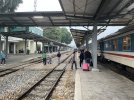
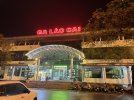


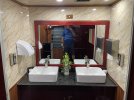
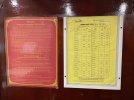
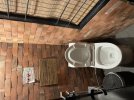
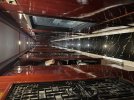

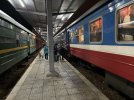
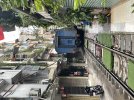
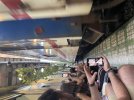
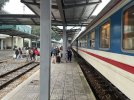
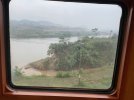
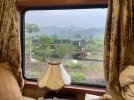
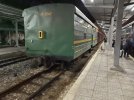
 Welcome to the world of trip reporting, hopefully there will be more to come soon as that was an enjoyable read.
Welcome to the world of trip reporting, hopefully there will be more to come soon as that was an enjoyable read.